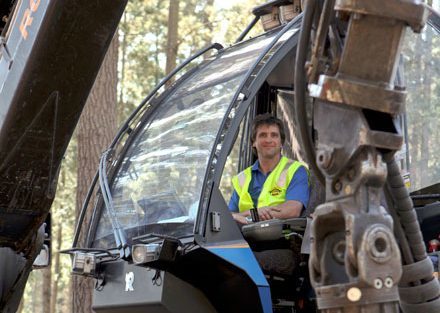
When it comes to harvesting the timber, the process doesn’t centre around axes and saws. Forest harvesting operators use complex machinery to cut it into precise logs to use as much of the wood as possible. Source: Timberbiz
“Forest harvesting operators work in high-risk environments so safety is a priority,” said Stacey Gardiner, General Manager of the Australian Forest Contractors Association.
“Trees are a long-term investment by the forest owner – as are the harvesting machines, which can cost upwards of $500,000 each. Harvesting operators are responsible for maximising the value recovered from these trees, which includes minimising waste and improving efficiency.”
Operators must have the skills to use computers on-board the logging machinery, which distinguish between various types of wood and more.
Adan Taylor, General Manager of GMT Logging – a family-owned and operated harvesting business based in Imbil, Queensland – knows just how complex these on-board systems can be.
“In our operations, there are 13 different log grades to choose from. The on-board systems gather massive quantities of data about lengths and diameters to build accurate profiles of trees. This enables the machine to predict what diameter a tree will be up to three metres ahead, and decide what log combination will maximise the value recovered,” said Mr Taylor.
Harvesting operators must also be able to perform preventative maintenance on their equipment, undertake quality control of log specifications, plan harvesting activity to limit stoppages for adverse weather conditions and grade logs into correct specifications.
They often work in areas without mobile phone reception and need to be able to comply with strict environmental guidelines, carry out first aid and assess risk of certain hazards.
Technical skills required are generally learned ‘on the job,’ through employer-led and supported training on-site, with specific competencies then assessed by a registered training organisation.
“In a specialised sector like ours, employers have to attract people with a more general manufacturing background, and support them into specialist training. We don’t have a pipeline of qualified harvesting operators rearing to join the industry; we’re competing with other employers and industries to get the best people,” said Mr Taylor.
While the sector had innovated, the vocational training units to get qualified hadn’t caught up. This resulted in a disconnect between the skills employers need and the units of competency required to obtain a nationally-recognised qualification.
Offering the opportunity to get a formal, specialist qualification is key to attracting people to such a specialised and growing sector – highlighting a need for up-to-date training.
Acknowledging this need, Mr Taylor took up the opportunity to join a Technical Advisory Committee (TAC) of industry stakeholders set up to support a review of units of competency within the Forest and Wood Products training package. This review was initiated by the Forest Management and Harvesting Industry Reference Committee (IRC), which provides advice to the Australian Industry and Skills Committee (AISC) about the skills needs of the sector.
The IRC and TAC reviewed 13 units of competency to both reflect the new job requirements and level of performance expected, and content to meet industry needs – particularly around process optimisation and the on-board computer technology.
Through this process, 10 units have been improved, two units added, and, reflecting technological change, one unit deleted.
As a result, the units now reflect the complexity of harvesting operations, but are also flexible enough to be tailored to workplace needs, acknowledging the varying types of wood harvested, environments, and technology used across companies.
The updates also mean people already in the workforce can have their skills recognised towards a qualification.
“For GMT Logging, this means young people who undertake on the job training can have it assessed against a qualification. Units will now reflect actual operator practices and requirements, improving relevance,” said Mr Taylor.
Modernised qualifications that more accurately reflect the work of harvesting operators could see more people in the sector have their skills formally recognised.
“The units will highlight just how skilled operators actually are – building recognition within the broader forestry industry.”
As technology and innovation lead to new products and processes, recognising the skills of forestry harvesting operators not only recognises their level of expertise but provides competencies that can be transferable in the future.





